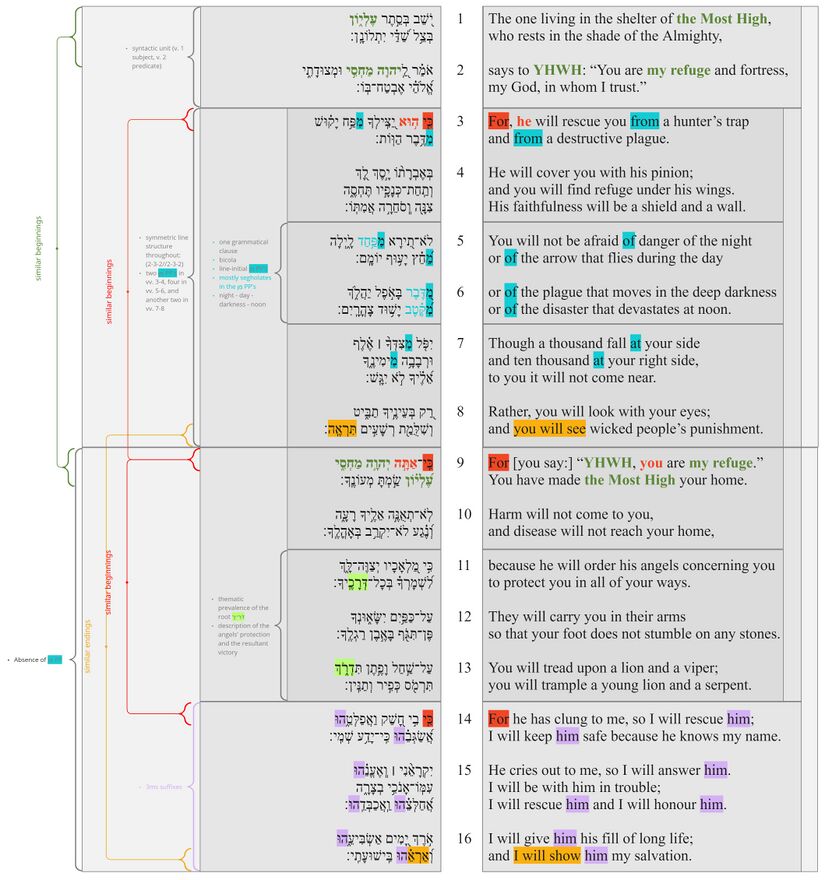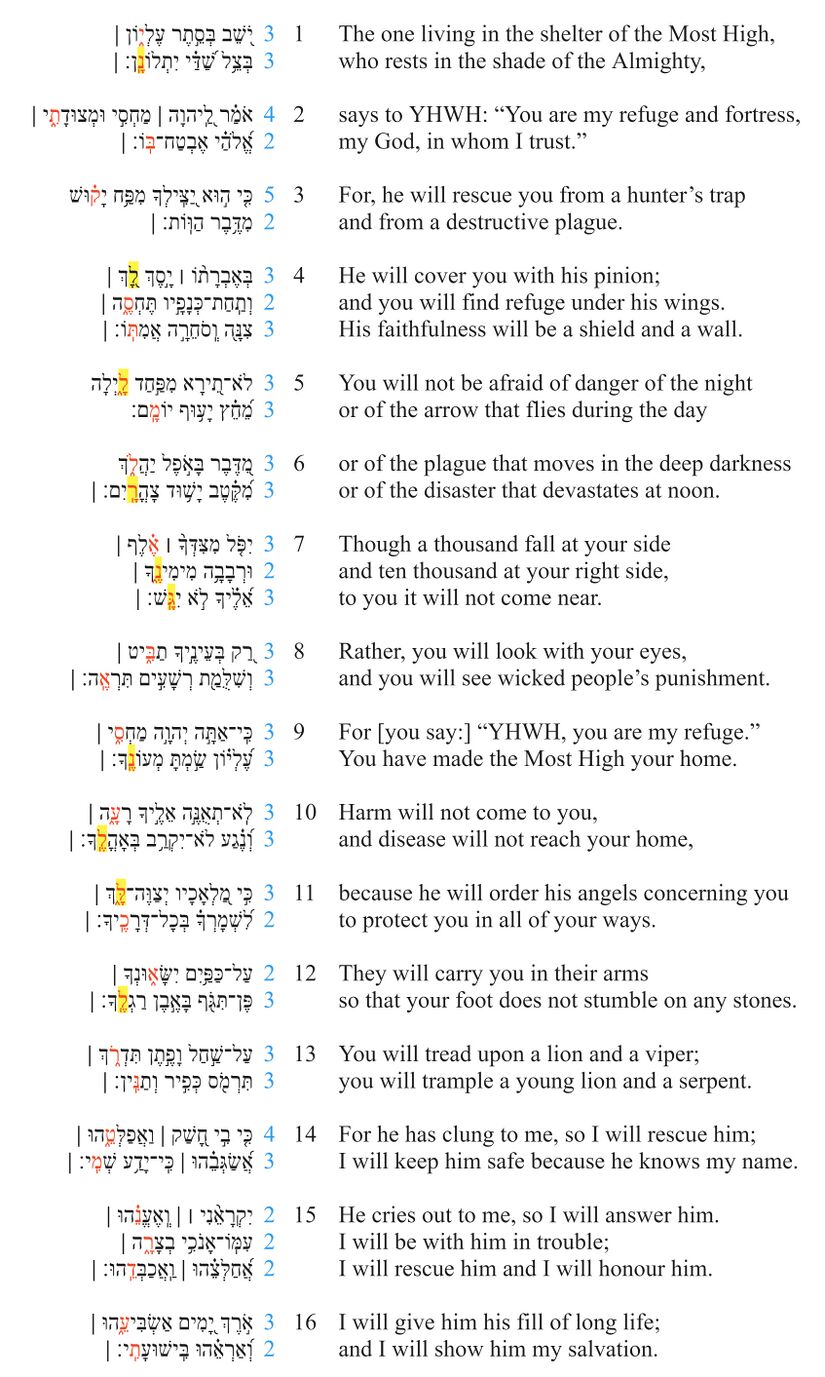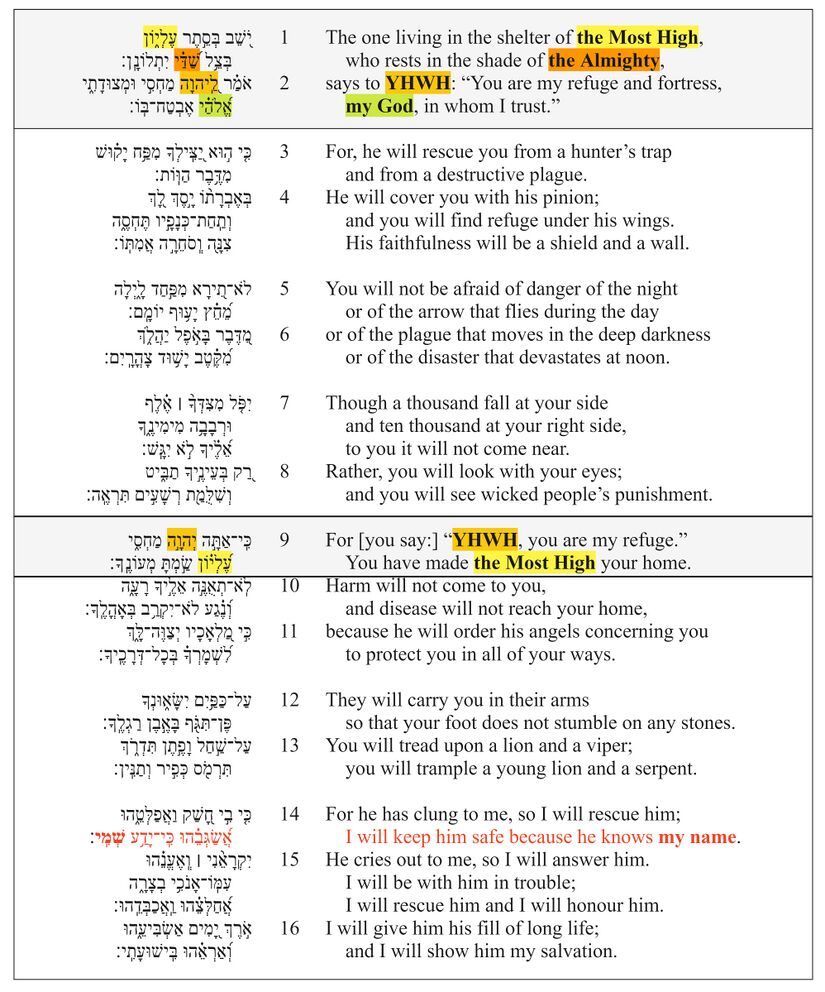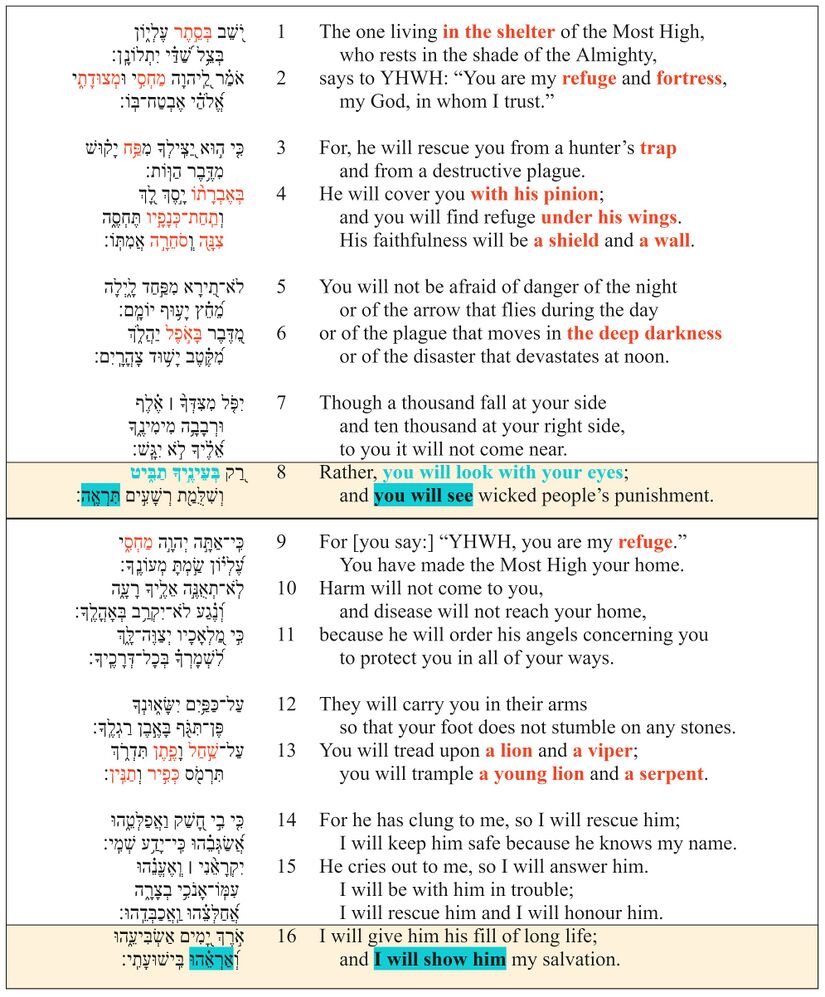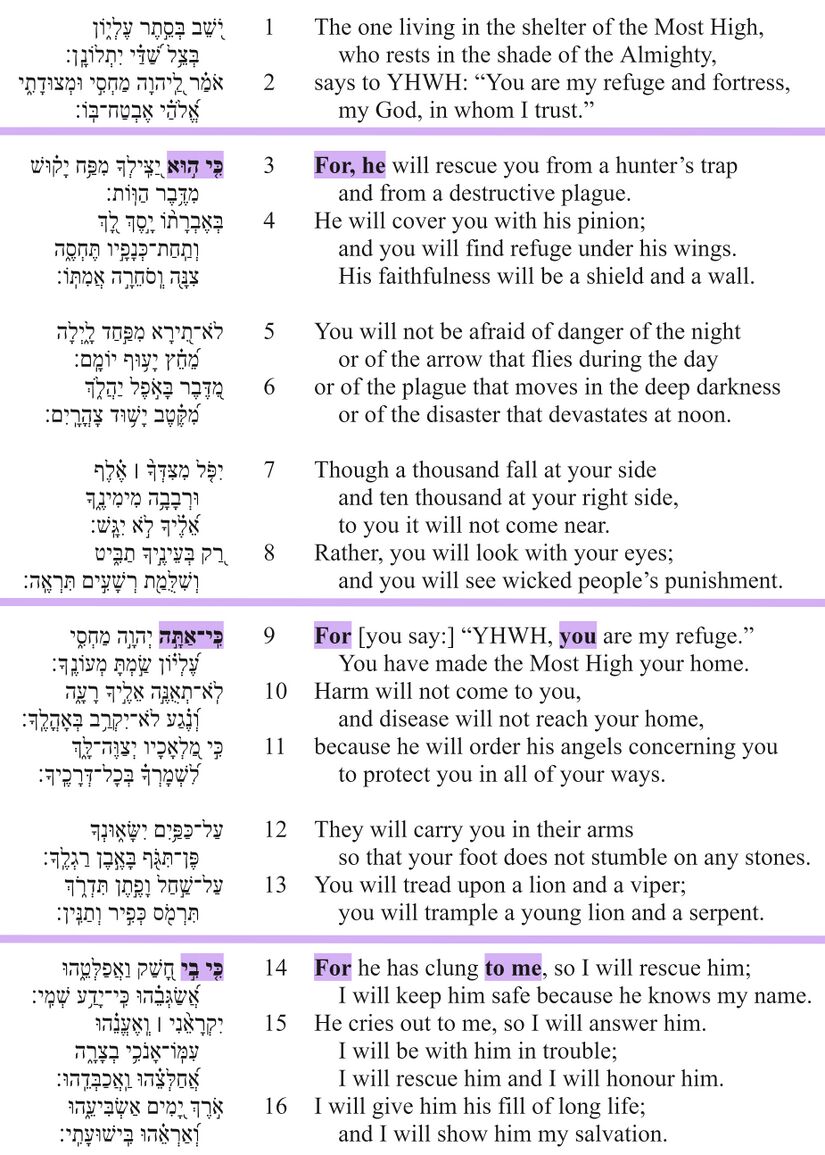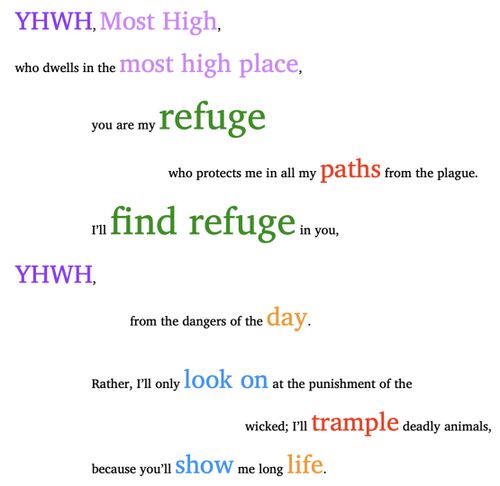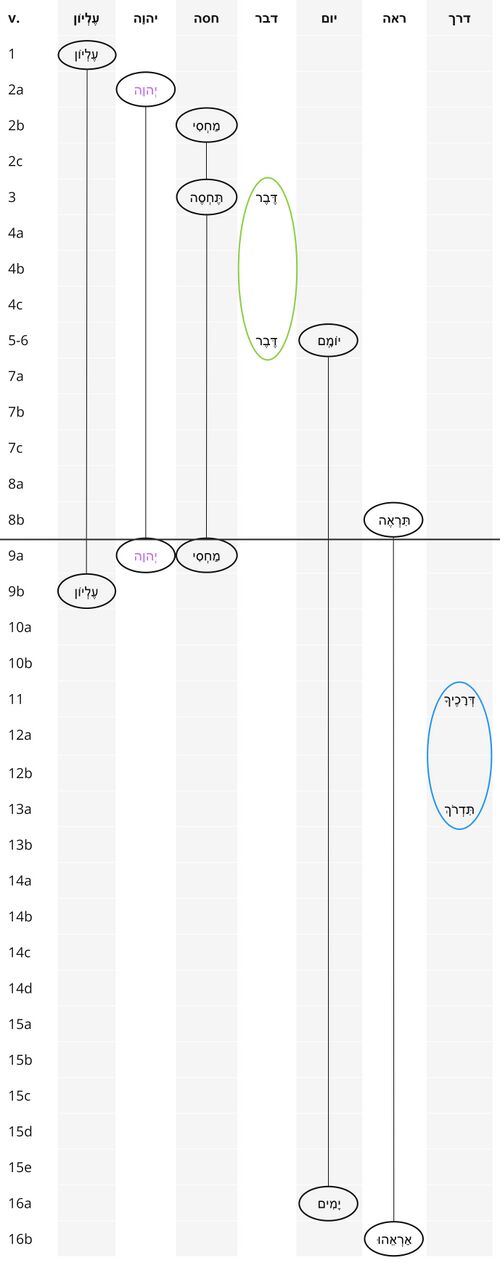Psalm 91 Poetics
About the Poetics Layer
Exploring the Psalms as poetry is crucial for understanding and experiencing the psalms and thus for faithfully translating them into another language. This layer is comprised of two main parts: poetic structure and poetic features. (For more information, click 'Expand' to the right.)
Poetic Structure
In poetic structure, we analyse the structure of the psalm beginning at the most basic level of the structure: the line (also known as the “colon” or “hemistich”). Then, based on the perception of patterned similarities (and on the assumption that the whole psalm is structured hierarchically), we argue for the grouping of lines into verses, verses into sub-sections, sub-sections into larger sections, etc. Because patterned similarities might be of various kinds (syntactic, semantic, pragmatic, sonic) the analysis of poetic structure draws on all of the previous layers (especially the Discourse layer).
Poetic Features
In poetic features, we identify and describe the “Top 3 Poetic Features” for each Psalm. Poetic features might include intricate patterns (e.g., chiasms), long range correspondences across the psalm, evocative uses of imagery, sound-plays, allusions to other parts of the Bible, and various other features or combinations of features. For each poetic feature, we describe both the formal aspects of the feature and the poetic effect of the feature. We assume that there is no one-to-one correspondence between a feature’s formal aspects and its effect, and that similar forms might have very different effects depending on their contexts. The effect of a poetic feature is best determined (subjectively) by a thoughtful examination of the feature against the background of the psalm’s overall message and purpose.
Poetics Visuals for Psalm 91
Poetic Structure
Poetic Macro-structure
- This poetic structure reflects Vreugdenhil's (2020:164-174) and van der Lugt's (2014:27) strophic analysis.
- While the MT's two instances of the root ראה is regarded to structure and conclude the psalm's two cantos (vv. 1-8//9-16), 11QPsApª reads לא תראה רעה in v.10a, which would dilute its privileged position in only vv. 8b and 16b.
Line Division
- Currently = LXX
- v. 2 - Kugel (1981, 115-116) suggests this is an example of scribal "forgetting" of parallelism, so that the atnaḥ is misplaced and ומצודתי should be placed on the B-line, resulting in 3-3. This doesn't solve v. 3, however, which (if כִּי is included) is even more "imbalanced" (5-2 vs. 4-2).
- v. 3 also has a slight break between these two lines in Aleppo; followed by L and Sassoon 1053.
- v. 4a-b suggested as one line by the spacing in Or 2373.
- v. 7b-c seem to be continued in Aleppo, Sassoon 1053, and definitely as one in Or 2373. L has a slight gap after אליך... (but then again, it also splits up 10b and 11b...)
- v. 15a-b suggested as one line in Or 2373.
- The only real imbalances are vv. 2-3 (11-6 syllables, 9-5 syllables respectively)
Poetic Features
1. Divine Names
Feature
Names/titles for God appear only in the parallel introductory sections of the two halves of the psalm (vv. 1-2 // v. 9; see poetic structure), and some of these names/titles are rare and specific. The least common name is שַׁדַּי (only occurring in 91:1 and 68:15 in the Psalter). Also, the name אֱלֹהִים, although common in the Psalter, occurs only once in Ps. 91, in v. 2. The names עֶלְיוֹן and יְהוָה also appear in these sections in a chiastic pattern: A. עֶלְיוֹן (v. 1a), B. יְהוָה (v. 2a), B. יְהוָה (v. 9a), A. עֶלְיוֹן (v. 9).
The most common place שַׁדַּי is used in the Hebrew Bible is in the book of Job, in which "what is characteristic of this reference to God is His 'physical proximity to the individual human being'" (Vreugdenhil 2020, 359). The name עֶלְיוֹן, by contrast, due to its etymology and semantics, carries nuances of height and superiority.
In v. 14b, the verb we have glossed keep safe, is from the verb שׂגב, more generally used as be high, inaccessible (HALOT, cf. Jerome exaltabo). The line continues, אֲ֝שַׂגְּבֵ֗הוּ כִּֽי־יָדַ֥ע שְׁמִֽי, so the king is explicitly said to know God's name, an expression only used here and in Ps. 9:11 in the psalter. In the following verse (v. 15b), God claims to be with the king, even in his troublesome circumstances.
Effect
The use of שַׁדַּי and עֶלְיוֹן at poetically-significant points in the psalm (vv. 1-2, 9) brings to the forefront of the psalm's message the reality that God is both in close proximity to the king (as שַׁדַּי) and superior to all of his enemies (as עֶלְיוֹן). It also highlights the assertion, in the final section of the psalm, that He knows my name (v. 14b).
The comforting nature of knowing God's name as שַׁדַּי is supported by God's promise to be with the king (v. 15b). The comforting nature of knowing his name as עֶלְיוֹן is supported by God's promise to lift him up high and keep him safe (שׂגב v. 14b).
The chiastic nature of עֶלְיוֹן and יְהוָה hint at the complete and integral nature of divine attributes involved in YHWH's salvation of the king.
2. Seeing is believing
Feature
The verb look/see (ראה) is structurally significant, being placed strategically in the last line of each of the main parts of the psalm. It is accompanied by you will look with your eyes in v. 8a.
At the same time, there are a number of references to secret/hiding places throughout the psalm, including the second word of the psalm (סתר shelter, literally: hiding place). The mention of 'wings' as well as 'shield' and 'wall' (v. 4) develops the imagery places which are not seen by enemies. Similarly, the psalm mentions a trap (v. 3a), laid in a secret place, 'danger of the night' (v. 5a), 'deep darkness' (v. 6a) and predatory animals who attack suddenly and unexpectedly from a hidden and stealthy position (v. 13).
Effect
All of these images of hidden objects are contrasted with the structurally-and semantically-privileged verb to see (ראה) within the psalm. Though the enemies will not see the hidden king, the first half of the poem ends with the king seeing the punishment of his supposedly hidden, viciously-attacking enemies, and the entire psalm concludes with YHWH causing to see, i.e., showing the king his salvation.
3. He, you, and me
Feature
The כִּי in vv. 3, 9 and 14 are discourse markers falling at the structural and poetic transitions of the psalm (see Macrosyntax, Speech Act, Participant Analysis and Poetic Structure and the exegetical issue:The Discourse of Psalm 91). (Although there is another כִּי in v. 11, this one directly subordinates its clause to v. 10, so is functioning differently.)
After the first discourse כִּי (v. 3) the speaker tells the king that he (הוּא), i.e. YHWH, will rescue him. At this point in the psalm, YHHW is present only as a third person participant.
After the second discourse כִּי (v. 9), the king himself speaks and addresses YHWH with an explicit 2nd person pronoun: you (אַתָּה). Thus, the psalm moves from third person he, to second person, you. The result of this movement is that YHWH becomes more personally involved in the discourse.
After the final כִּי of the psalm (v. 14a), YHWH himself speaks, referring to himself in the phrase to me (בִי) (which, like he and you, is fronted) and in the phrase my name (שְׁמִי) (v. 14b). The first person language continues unabated until the end of the psalm.
Effect
Little by little, YHWH and his salvation (v. 16b) take centre-stage. No longer is he an absent discourse participant being spoken about (v. 3), but after being directly addressed (v. 9) confirms (v. 14) the prophetic promises himself. So even when trouble comes, YHWH is not absent; he is right there with the king (v. 15b)!
Repeated Roots
The repeated roots table is intended to identify the roots which are repeated in the psalm.
For legend, click "Expand" to the right
